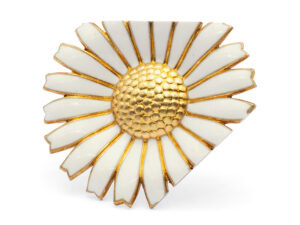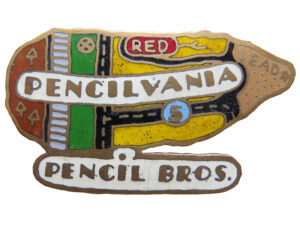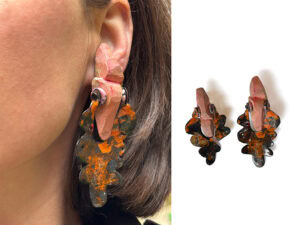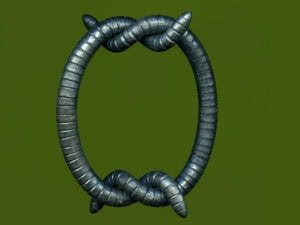
The other day I found Benjamin Lignel’s recent post in Art Jewelry Forum, ‘Just what is it that makes today’s art galleries so different, so appealing?’ It was a teasing title. A quick Google revealed its source as a collage by Richard Hamilton, satirizing 1950s consumerism.
So what makes the art gallery so appealing for contemporary jewelry? Benjamin was reflecting on the first exhibition of contemporary jewelry at Gargosian Gallery, arguably the most prestigious commercial visual art space on the planet. It was an occasion well worth noting. What followed was a series of salutary disappointments. Rather than select a known figure of the contemporary jewelry scene, Gargosian chose the work of a fashion designer with Dior, Victoria de Castellane.

The other day I found Benjamin Lignel’s recent post in Art Jewelry Forum, ‘Just what is it that makes today’s art galleries so different, so appealing?’ It was a teasing title. A quick Google revealed its source as a collage by Richard Hamilton, satirizing 1950s consumerism.
So what makes the art gallery so appealing for contemporary jewelry? Benjamin was reflecting on the first exhibition of contemporary jewelry at Gargosian Gallery, arguably the most prestigious commercial visual art space on the planet. It was an occasion well worth noting. What followed was a series of salutary disappointments. Rather than select a known figure of the contemporary jewelry scene, Gargosian chose the work of a fashion designer with Dior, Victoria de Castellane.
Benjamin’s review was characteristically incisive, critiquing the show not only for its cloying craftsmanship, but also for its disdain of wearability. Indeed, the images of work online did look like wearable Dale Chihuly miniatures. It seemed to confirm the seeming irreconcilable separation of contemporary jewelry and visual art.
But this wasn’t the reason that Lignel’s review unsettled me. I had already braced myself for the news that a visual arts gallery was not sensitive to the unique qualities of contemporary jewelry.
It was something else. In describing the theme of Castellane’s show, Benjamin left a question hanging. The exhibition was titled Fleur d’excès and featured ten ‘unique precious objects’ each celebrating a different drug, such as Heroïna Romanticam Dolorosa and Crystalucinae Metha Agressiva. According to the accompanying media release, ‘Hallucinatory drugs and their promise of mind-expansion have fascinated and inspired artists the world over. De Castellane’s flowers are intoxicating, but also dangerous because of the poisons that they secrete. Here they personify the Romantic idea of women “under the influence”.’
So, this inaugural show of contemporary jewelry is a celebration of drug addiction. That is not surprising in a Gargosian context. Elite contemporary art defines itself against mainstream values, particularly tight-assed middle class morality. But it is sobering to learn that this is how contemporary jewelry is located – as a sphere of decadent excess.
Rather than signify an enduring amorality in art jewelry, this review brought more starkly into relief the opposing trends in our scene today – established European aestheticism versus emerging United Statesian activism. These positions seem largely at odds with each other. The celebration of individual originality is cancelled out by the urgent call for collective action.
That’s the question: what’s the place of ethics in the world of contemporary jewelry?
Ethics has become a broad dimension of our critical engagement with the world. We are less likely now to skip down the supermarket aisle, grabbing seductively packaged goods from the shelves. Now each product demands careful scrutiny. We look first at the list of ingredients for substances that are harmful to ourselves or the world. We Google the brand on our smart phones to see how it fares on ethical checklists.
The same applies to cultural consumption. In Australia, we prefer that films made about Indigenous culture are made by Indigenous people themselves. Celebrity artists like Anthony Gormley and Ai Wei Wei are valued not just for their art, but also for their visions of global democracy.
Meanwhile, the broader world of jewelry is embracing ethical agendas. Standards such as Walmart’s Terracycle and industry initiatives like greenKarat attempt to counter anxieties about ‘blood diamonds’: the universal symbol of love should not be tainted by the violence of civil war. Jewelers working in Africa like Sarah Rhodes and Martina Dempf, as well as environmental projects like CO2 pins, currently sit on the edges of contemporary jewelry. Can we broaden the field to include ethical practices?
At first glance, ethics appears far too blunt an instrument. You can’t make an ornament out of morality. So does this mean that contemporary jewelry must exempt itself from our otherwise ethical engagement with the world? Aesthetics has no room for ethics.
But rather than despair at this opposition, we can gain some mileage out of its dialectical tension. To move the argument along, let me try ramping up the opposition between the aesthetic and ethical. I hope by this means that we can develop an understanding of contemporary jewelry that might encompass both its aesthetic roots and the critical ethical response.
Thesis: the aesthetic
The world of contemporary jewelry is one of wit and excess. The scene is mercifully too boutique to be bothered with the same rules as apply to earnest worldly activities, like books or computers. It minds its own business. This endogamous morality of contemporary jewelry is based on four principles.
1.Conviviality
After all, shouldn’t there be some space in our world for pure pleasure? As Ortega y Gasset once said, ‘Humans are animals for whom only the superfluous is necessary.’ Jewelry is the space of friendship, not strategic alliances. It is only by putting the world at a distance that we can enjoy the spontaneity, freedom and downright wickedness of good friendship. Friendship is more an art than it is a science.
Contemporary jewelry will only be a relatively minor scene in the broader context of world art. It exists independently of grand statements as found in biennales or glossy magazines. Rather, it is underpinned by the personal liaisons between jewelers, clients, professors and curators. As such, it values individuality – the recognition of each other’s uniqueness.
When the Economist devoted an article to the field, it concluded, ‘Humour and subversion are an intrinsic element of this kind of jewelry’. As Peter Skubic claims, ‘The only rule is that there are no rules. It’s all just a good laugh.’
2.Internal currency
Contemporary jewelry eschews external forms of value, particularly money. Jewelry should not be reduced to its exchange value. It is better to use non-precious materials, whose value is derived from its position internal to the artistic field, rather than precious metals or stones that can carry a value which can circulate outside the scene. In removing itself from the real world of precious metals, contemporary jewelry absolves itself of the politics of global wealth distribution.
3.The game
The self-referential nature of contemporary jewelry is essential to its meaning. It’s a game. But this is not to dismiss it as a pastime without depth. It’s a tremendously serious game, testing its participants to their utmost in craftsmanship, intelligence and audacity.
Contemporary jewelry is hardly unique in being a world of its own. The most significant human pursuit on the global stage is no doubt the field of sport. Here we applaud the efforts of the athlete or team, despite the utter uselessness of its outcome. And in the other side of sport, the world of work, professionalism and passion for success are seen as the mark of a modern executive, regardless of which company they work for. The end is a pretext for the means.
Such a devotion to the game is not unique to modernity. Around two thousand years ago, in the great Indian epic Bhagavad Gita, the Lord Krishna argues the case for war, despite the meaningless loss of life it entails. For Krishna, the earthly consequences of battle are not as important as the honor that will be upheld in the process. The supreme value of Dharma transcends any worldly relevance. Above all, one must follow one’s chosen path in life, one’s Karma Yoga.
So rather than dismiss contemporary jewelry as a ludic venture, this becomes its virtue. As Picasso said, ‘Art is a lie that makes us realize the truth.’ Contemporary jewelry is thus a field in which we can exercise rare qualities that are essential to life. Through it we forge friendships and exercise our capacities independent of any compromise with the world outside. Far from amoral, the aesthetic dimension of contemporary jewelry is pure deontology.
Antithesis: the ethical
Whereas on the other hand . . .
Aestheticism attempts to create a set of values that seem independent of worldly forces. But rather than exist outside the system, its purpose is precisely to support it by offering an alibi –taste. Rather that basing class difference on brute economic power, it is seen to be founded on individual sensibility. Thus, the working class are not of low status because they lack money, but because they don’t have the inner taste to appreciate finer things. It’s their own fault.
1.Surplus capital
Jewelry itself is pure surplus capital. In its traditional form, jewelry functions to store value that is in excess of requirements. What’s left of the harvest once immediate needs are met is exchanged for precious metals that are fashioned to fix on the body of women. Surplus capital can then circulate along kinship systems with the exchange of women in marriage. Traditional jewelry is simply a portable bank account. Today we have plastic credit cards. In detaching itself from the currency value of jewelry, contemporary jewelry becomes surplus of a surplus. It marks a class society where the capacity to own precious jewels is no longer a marker of high status.
2.Status symbol
Capital investments can sometimes have another purpose. A house can also provide shelter, a vehicle transport. In the case of jewelry, there is no purpose other than to identify one’s social status.
While it does serve as a reserve of capital that can be drawn on when convenient, it also provides an overt symbol of class. In many societies, only certain classes are eligible to wear particular types of jewelry. According to the sumptuary rules in Renaissance Europe, commoners were forbidden from wearing pearls. In feudal India, only the Brahmin caste could wear gold. Traditional jewelry provides a vertical society with the ceiling that prevents movement up its hierarchy.
Contemporary jewelry appears to contest this by questioning the value of economic capital in jewelry. But this isn’t about re-investing wealth into worthy causes – melting down gold to buy food for the starving. It is rather about increasing the freedom of the artist to experiment with materials. The results then become markers of a cultural elite who use it to distinguish themselves from both the bling below and pearls above. These are just a postmodern version of feudal sumptuary laws.
3.War footing
While in the past we might have been able to afford the indulgence of ornament, it’s a different matter today. The phenomenon of climate change has prompted a ‘war-footing’ for all human endeavors. Everything has to be accounted for its terms of its effect on our rapidly diminishing planet.
Even a seemingly incidental a practice such as contemporary jewelry – the surplus of a surplus – is now being taken to account for its environmental impact. The USA collective Ethical Metalsmiths was launched at SNAG in 2005 as an attempt to introduce political action into contemporary jewelry. It addressed the immediate impact of jewelry in the well-documented environmental damage caused by mining.
While relatively insignificant as a user of such resources itself, contemporary jewelry can operate as an advocate for more responsible practices. Ethical Metalsmiths draws on the DIY sensibility that has been the main source of energy in contemporary craft thus far in the third millennium. DIY is about the solidarity of makers using the free market to contest dominant corporate powers. Radical Jewelry Makeovers bring communities together to transform out-dated items into re-charged jewels with fresh value. Such activities escape the consumerist treadmill that seeks always for the new, quickly replacing last year’s fashion with next year’s rubbish. The makeover re-charges the unloved object with the magic of social exchange.
The game’s over, contemporary jewelry. You are either with us or against us. You are either contesting the system that is destroying the planet or you are supporting it by providing a distraction from the main issue.
Dialectic: Keep moving
The aesthetic and the ethical seem diametric opposites. One argues for an entirely internal set of values, the other brings jewelry to account in its external effects. Maybe they both have a place in contemporary jewellery. As Liesbeth den Besten notes ‘author jewellery’ sits in between elite art and democratic design – the freedom to be original and the duty to serve the people.
What kind of space can we find to bring these positions together? But perhaps it’s not a space at all, but rather a time that they share: a cycle of growth and destruction.
The aesthetic position provides a generative platform for the creativity. It’s hard to contest that part of what we do to make life meaningful is produce things of beauty. But without some external intervention, such a scene threatens to become in-bred. Aestheticism is a point in a cycle which must at some stage be pruned by a fundamentalism if it is not to decay. The over-indulgence of Victorian taste eventually needed the Arts & Crafts movement to re-ground English decorative arts.
Ethical Metalsmithing comes at a time when contemporary jewelry needs to re-connect with the wider world. It draws on our anxieties about ‘blood diamonds’ and prompts us to examine the conditions that make jewelry possible. The taint of exploitation jars particularly with the seeming innocence of jewelry from the wider world. This provides an opening for alternative self-sufficient systems such as the DIY movement.
But we must be wary of the fundamentalism that is housed within the ethical turn. The idea of a ‘war-footing,’ in which all human activities must be brought to a common account is a condition of totalitarianism. We see a version of that today in the unstoppable growth of managerialism. The growing democratic expectations of government have led to a greater sense of accountability for what might be seen as elite cultural institutions, such as state art galleries. Government support for art practice is increasingly beholden to instrumentalist outcomes, such as social cohesion, job creation or environmental sustainability. Rather than serve the people, such processes support a technocratic society more interested in control than justice.
To prevent fundamentalism ossifying into bureaucracy, we need to keep extending the field of action. Beyond Ethical Metalsmiths, there are many other future courses of action. Let me conclude by mentioning three potential developments in engaged jewelry.
1.Agiprop
Rather than focus only on issues like mining that are directly related to jewelry, it is possible to use the viral capacity of body ornament to send messages of great political moment. We saw the potential for this with the ‘Make Poverty History’ white silicon bracelet, which was instrumental in focusing the attention of the G8 summit on the reduction of poverty. The Millennium Goals that it produced have been remarkably successful in alleviating the condition of suffering. The challenge here is to find a way in which a wave of support can be interlinked by body ornament that gives it daily visibility. If only we could find the viral ornament to cohere action around climate change.
2.Microsocial
Besides the environment, the other major currency of creative endeavor in our century is the social network. Facebook has leapfrogged millennia of social traditions and provided us with ideal tools for maintaining networks of friends, family and acquaintances. If anything, it is too successful. Allow Facebook to rummage through your address book and you’ll soon have thousands of friends – at the click of a mouse. The global success of Facebook now confronts us with the challenge of recovering the ties that bind close friends.
Jewelry remains a hard currency of friendship. Pins, bracelets and rings can be given as markers of a relationship that invests in a future. Unlike status updates, they are personal. Jewelry has an important role in contemporary society by re-connecting people.
3.Poor jewelry
While the use of rubbish to make jewelry can demonstrate the ingenuity of the maker, it can also be used as a strategy for subverting social hierarchies. Popular social movements such as the South African freedom struggle found expression in what has been called a ‘re-discovery of the common.’ The use of readily available materials from the street finds parallel with the democratic energies that seek to give power to the masses over the repressive elites.
The Chilean poet Pablo Neruda tried to achieve something similar in writing classical odes for common objects, such as a pair of scissors or an orange. Conventionally, social change is reflected in bling, which signifies an aspirationalism whereby an individual can rise above their ranks to join the privileged elite. By contrast, the ‘poor jewelry’ represents a solidarity that contests the hierarchy as a whole.
Onwards
Ethical Metalsmiths are the fundamentalists of our time. They represent a break with a tired aestheticism. But in following their lead, we do not have to be limited to one particular paradigm of engagement. Ethical Metalsmiths have opened the door. But neither we nor they have to linger around the entrance. There are many interesting alternatives ahead.
Inevitably, particular individuals will begin to stand out as especially innovative in their work. They will gain recognition in a field of other individuals. And eventually aestheticism may flower again, just as the garden regains it bloom after a radical pruning.
The ambivalence of contemporary jewelry towards ethics is not a bad thing. Aesthetics prevents mindless moralism: it keeps us honest. But without ethics, we are left talking to ourselves.
See you at the pearly gates.





